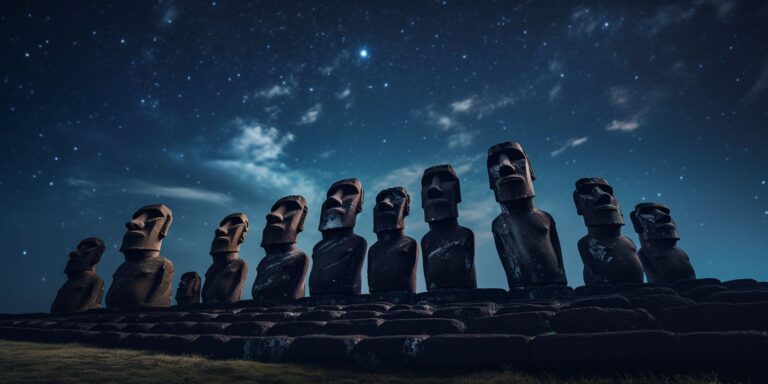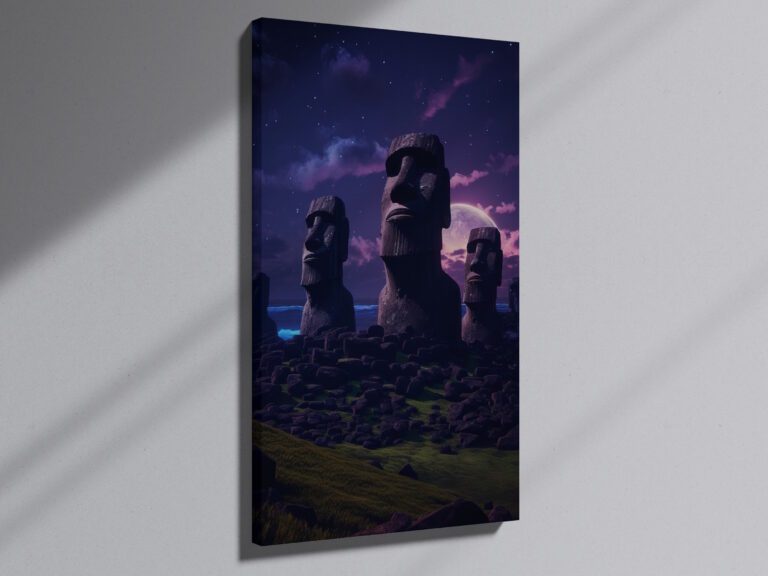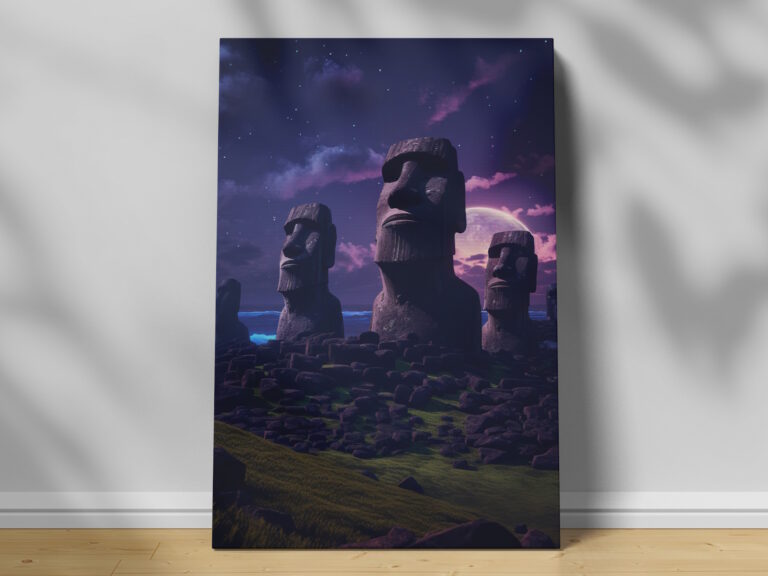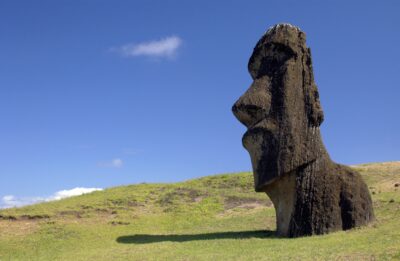Nestled amidst the vast expanse of the Pacific Ocean lies a remote and enigmatic island that has captured the imagination of adventurers, archaeologists, and dreamers for centuries – Easter Island, known to its indigenous inhabitants as Rapa Nui. It is a place of mystical allure, where rolling hills and lush green landscapes give way to a peculiar and haunting sight: colossal stone statues known as Moai. These monolithic giants, with their stoic gazes and austere countenances, are not mere sculptures but silent sentinels to a forgotten past, standing as testaments to the ingenuity and mysteries of a bygone civilization.
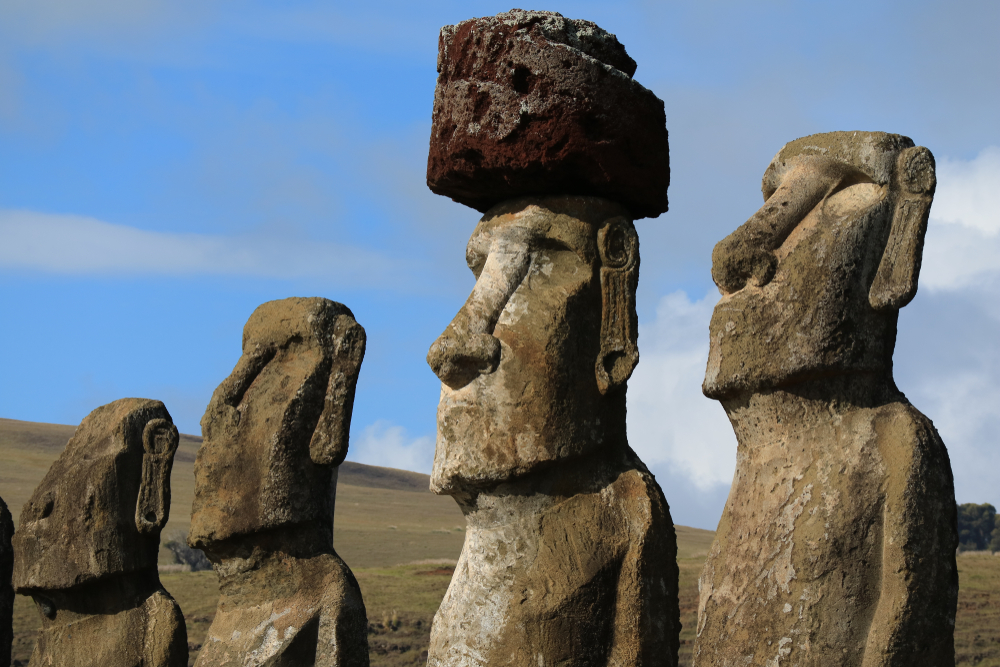
In this exploration, we embark on a journey to uncover the secrets that shroud the Moai statues of Easter Island. We shall delve into the annals of history to understand the context in which these enigmatic figures were carved, discover the intricate details of their construction, and unravel the myriad theories that have sought to explain their purpose. From the revered topknots that adorn some Moai to the monumental platforms known as Ahu, from the environmental challenges faced by the ancient Rapa Nui people to the enduring cultural significance of these statues in the present day – our quest is to peel back the layers of time, piece by piece, and unveil the truths and mysteries that have fascinated generations.
The story of the Moai transcends mere archaeological curiosity; it is a testament to human determination, creativity, and the ability to adapt to challenging environments. It is also a stark reminder of the delicate balance between nature and culture, as the ecological changes wrought by human hands are etched into the very stones of Easter Island. Join us as we embark on a voyage to uncover the enigmatic past and vibrant present of Easter Island’s Moai, and in doing so, perhaps catch a glimpse of the profound mysteries that continue to shroud these timeless sentinels.
Historical Background of Easter Island
To understand the enigma of the Moai statues, it is essential to embark on a journey into the historical tapestry of Easter Island, which is believed to have been settled by Polynesians between the 7th and 13th centuries CE. These intrepid seafarers navigated the vast expanses of the Pacific Ocean, relying on celestial navigation and their knowledge of ocean currents, eventually arriving at this remote landmass.
The indigenous people of Easter Island, known as the Rapa Nui, brought with them a unique Polynesian culture that would evolve in isolation over the centuries. They developed a complex society with a deep connection to the land and sea, crafting a way of life that revolved around sustainability and resource management.
Central to Rapa Nui culture were the Moai, the colossal stone figures that have since become synonymous with the island. These statues, carved from the volcanic rock of Rano Raraku, represented not only artistic and engineering achievements but also carried profound cultural and spiritual significance. They were more than just stone; they were vessels of ancestral spirits, protectors of the people, and symbols of authority.
The process of carving and erecting the Moai was a communal endeavor that involved the collective labor of the Rapa Nui society. It required the extraction of massive stone blocks from the quarry, meticulous shaping and carving, transportation across the island’s rugged terrain, and finally, placement on stone platforms known as Ahu. These remarkable feats of engineering and artistic craftsmanship stand as a testament to the ingenuity and dedication of the Rapa Nui people.
Over time, Easter Island saw the creation of hundreds of Moai, varying in size and style, each one a unique representation of the island’s cultural and historical evolution. They served as markers of lineage and status, and the erection of these statues on the Ahu was accompanied by elaborate ceremonies and rituals, underscoring their spiritual importance.
However, as the centuries passed, Easter Island’s isolation took its toll. The island’s limited resources, particularly its forests, were gradually depleted in the pursuit of carving and transporting the Moai, leading to ecological degradation. This, coupled with social and possibly political factors, culminated in a decline of Rapa Nui society, leaving behind a landscape dotted with unfinished statues and toppled Moai.
The arrival of European explorers in the 18th century brought Easter Island to the attention of the wider world, sparking curiosity and inquiry into its enigmatic statues. These explorers documented their observations, igniting interest in this remote corner of the Pacific.
As we delve deeper into the historical backdrop of Easter Island, we begin to grasp the rich cultural tapestry from which the Moai emerged. It is within this context that we must seek answers to the many questions that continue to shroud these stone sentinels, from the purpose of their creation to the intricacies of their construction and the ecological impact of their legacy. To unravel the mysteries of the Moai, we must first understand the world that gave rise to them—the world of the Rapa Nui.
Theories & Purpose of the Moai Statues
The Moai statues of Easter Island stand as mute witnesses to centuries of speculation, debate, and intrigue. Their enigmatic presence has spurred a multitude of theories and hypotheses attempting to unravel the mysteries that shroud these colossal stone guardians.
The Purpose of the Moai
One of the most enduring debates surrounding the Moai centers on their purpose. Multiple theories have emerged over the years, each offering a different perspective on why these statues were carved and erected:
Ancestral Worship: Some researchers propose that the Moai were created to honor ancestors. According to this theory, the statues represented deified ancestors who watched over and protected their descendants. The act of carving and erecting these statues was a form of spiritual communion.
Political Significance: Another theory suggests that the Moai served as symbols of authority and political power. These massive statues might have been created to demonstrate the prestige and status of certain clans or leaders. Their placement on the Ahu platforms could symbolize territorial claims.
Navigational Aids: An unconventional theory posits that the Moai had navigational purposes. Some researchers suggest that the statues were strategically placed to serve as landmarks for seafaring Polynesians, aiding in navigation across the vast Pacific Ocean.
Cultural Identity: The Moai could have been expressions of cultural identity and community pride. The process of carving and erecting these statues might have been a way for the Rapa Nui people to assert their cultural distinctiveness and unity.
Ritualistic or Ceremonial Objects: Some theories propose that the Moai were used in rituals or ceremonies, possibly involving the placement of offerings or the observance of religious practices.
Construction Techniques
The construction of the Moai has long been a subject of fascination and debate. One of the most puzzling aspects is how these massive stone figures were carved, transported, and erected using the limited technology available to the Rapa Nui people:
Carving Techniques: The precision and artistry of the Moai’s features raise questions about the tools and techniques employed in their creation. It is still a matter of speculation whether the Rapa Nui used stone, wooden, or bone tools to carve the statues.
Transportation Methods: Perhaps one of the most iconic images associated with the Moai is that of these statues being transported across the island’s rugged terrain. Theories abound regarding how the Rapa Nui managed to move these massive stone monoliths from Rano Raraku quarry to their final locations.
Erection of the Moai: The process of placing the Moai on the Ahu platforms is another engineering challenge that continues to intrigue researchers. Theories range from the use of ropes, ramps, and levers to even the possibility of rocking the statues into position.
Ecological Impact and Decline
The construction and transportation of the Moai are not only subjects of technical debate but also critical components of discussions about Easter Island’s environmental history. The theory of ecological collapse posits that the island’s deforestation, primarily for the purpose of moving the statues, contributed to the decline of the Rapa Nui society.
Deforestation: The extensive felling of trees to create wooden sledges and rollers for transporting the statues is believed to have led to deforestation on Easter Island. This environmental degradation could have resulted in soil erosion, loss of biodiversity, and a decrease in available resources.
Social Implications: The theory suggests that as resources dwindled and the environment deteriorated, it led to social upheaval, resource scarcity, and a decline in the island’s population.
Cultural Legacy: The ecological impact of Moai construction raises questions about the relationship between human societies and their environments, prompting discussions about sustainability, resource management, and the consequences of short-term decisions on long-term survival.
As we contemplate these theories and debates surrounding the Moai, it becomes evident that each answer discovered leads to new questions. The enigma of the Moai continues to challenge our understanding of Easter Island’s history, culture, and the remarkable achievements of its ancient inhabitants. In the subsequent sections, we will delve deeper into the archaeological discoveries and contemporary efforts to uncover the truth behind these enduring mysteries.
Uncovering the Mysteries of the Moai
The mysteries of Easter Island’s Moai statues are like a puzzle with missing pieces, waiting to be uncovered by diligent archaeologists, historians, and researchers. Through painstaking excavations and comprehensive studies, dedicated individuals have made significant strides in shedding light on the enigma that surrounds these iconic stone figures.
Archaeological Endeavors
The quest to understand the Moai and the culture of the Rapa Nui people has been ongoing for centuries, but it gained significant momentum in the 20th century. Archaeological excavations and investigations have played a pivotal role in unearthing crucial information about these ancient statues:
Rano Raraku Quarry: Rano Raraku, the quarry where the Moai were carved, has been a focal point for archaeological research. Excavations at this site have revealed numerous unfinished statues in various stages of production. This has provided valuable insights into the carving techniques and tools used by the Rapa Nui people.
Ahu Platforms: The stone platforms known as Ahu, on which the Moai were erected, have been subjects of extensive study. Researchers have examined the construction methods, the structural engineering behind these platforms, and the layers of history hidden beneath them.
Statue Conservation: Ongoing efforts in the preservation and restoration of Moai statues have helped protect these ancient treasures from further deterioration due to environmental factors and human activity. These conservation projects also provide opportunities for close examination and study.
Radiocarbon Dating and Chronology
Establishing an accurate chronology for the creation and erection of the Moai has been a critical aspect of research. Radiocarbon dating of organic materials found in association with the statues has provided a more refined timeline for their production and placement on the Ahu platforms.
Symbolism and Iconography
In addition to the physical aspects of the Moai, researchers have delved into the symbolism and iconography associated with these statues. They have explored the cultural, religious, and spiritual significance of the Moai in the context of Rapa Nui society. The presence of red pigment on some statues has sparked discussions about their ceremonial use.
Environmental Impact Studies
The theory of ecological collapse on Easter Island has led to interdisciplinary studies that examine the relationship between the Rapa Nui people and their environment. Scientists have conducted pollen and soil analyses, among other research, to gain insights into the island’s ecological history and the impact of human activities on its ecosystem.
DNA Analysis and Ancestral Research
Genetic studies involving the Rapa Nui people have provided valuable information about their ancestry and connections to other Polynesian populations. These studies have contributed to a broader understanding of the cultural and genetic heritage of Easter Island’s inhabitants.
Monolithic moai statue on Easter Island (Rapa Nui) in the South Pacific. It has been administered by Chile since 1888. UNESCO World Heritage Site.
Through these collective efforts, a clearer picture of the Moai’s history, purpose, and cultural context has emerged. While many questions remain unanswered, the ongoing research and discoveries continue to unravel the mysteries that surround these iconic statues. As we explore the archaeological treasures and scientific revelations associated with the Moai, we gain deeper insights into the world of the Rapa Nui and the enduring legacy of their remarkable civilization.
Enviornmental Impact
The story of Easter Island’s Moai is not just a tale of artistic and engineering achievements but also a cautionary tale about the intricate interplay between human societies and their environments. Central to the ongoing discussions about the Moai is the theory of ecological impact, which posits that the construction and transportation of these colossal statues had profound consequences for the island’s ecosystem.
Deforestation and Resource Depletion
One of the most striking and well-documented aspects of the ecological impact theory is the extensive deforestation of Easter Island. The Rapa Nui people required vast quantities of wood to create the tools, sledges, and rollers necessary for carving and transporting the Moai. Over time, this relentless demand for timber led to the depletion of the island’s forests.
Resource Management: The question of why the Rapa Nui continued to exploit their limited resources, despite the potential consequences, remains a subject of debate. Some researchers argue that the construction of the Moai may have been a result of social pressures or a desire to assert clan or individual prestige.
Impact on Biodiversity: Deforestation not only affected the availability of timber but also led to changes in the island’s biodiversity. Loss of tree cover resulted in soil erosion, disruption of habitats, and a decline in plant and animal species.
Soil Erosion and Agricultural Challenges
The loss of trees and the resulting soil erosion had a direct impact on the island’s agricultural practices. Rapa Nui agriculture relied on terraced fields known as “manavai” and gardens, which were essential for sustaining the population.
- Soil Fertility: Erosion caused by deforestation decreased soil fertility, making it increasingly difficult to cultivate crops. The decline in agricultural productivity exacerbated resource scarcity and may have contributed to social instability.
Resource Scarcity and Decline of Society
As resources on Easter Island dwindled, it is believed that the Rapa Nui society faced growing challenges related to food security, population pressure, and access to essential materials. The ecological impact theory suggests that these challenges may have played a significant role in the decline of the island’s population and cultural fragmentation.
- Resource Redistribution: Some theories propose that the construction and transportation of the Moai may have been a means of redistributing resources and reinforcing social hierarchies within the society.
Lessons for Sustainability
The story of Easter Island’s ecological decline serves as a powerful lesson in the study of environmental sustainability. It highlights the delicate balance between human societies and their ecosystems, underscoring the consequences of short-term decisions that prioritize immediate needs over long-term ecological health.
Contemporary Relevance: The lessons drawn from Easter Island’s history have relevance in today’s world, where sustainable resource management and conservation are critical for mitigating environmental challenges.
Conservation and Restoration: Modern efforts to protect and restore Easter Island’s environment include reforestation projects, soil conservation measures, and initiatives to address the ecological consequences of past actions.
In examining the environmental impact of the Moai, we confront the complex interplay between culture, resource management, and ecological sustainability. Easter Island’s story serves as a stark reminder of the need for responsible stewardship of our environment and the consequences that can result when societies fail to prioritize long-term sustainability. As we continue our exploration of the Moai and the Rapa Nui civilization, it is essential to consider the broader implications of their history for our planet’s future.
Conclusion
The Moai statues of Easter Island, despite their ancient origins, continue to hold profound cultural and spiritual significance for the modern Rapa Nui people. As we delve into the contemporary relevance of these iconic stone figures, we gain insights into the enduring legacy of the Moai in the lives and traditions of the island’s inhabitants.
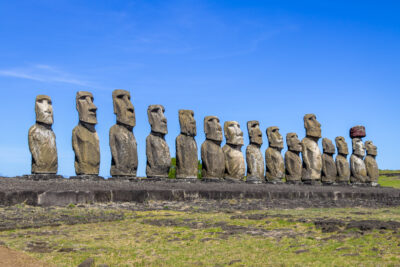
Cultural Revival and Identity
In recent decades, there has been a resurgence of interest in Rapa Nui culture and traditions. The Moai statues play a central role in this cultural revival, serving as potent symbols of identity, heritage, and resilience.
Cultural Reawakening: The revival of traditional dance, music, language, and art has rekindled a sense of pride and connection to Rapa Nui’s rich cultural heritage. The Moai statues are integral to this resurgence, providing a tangible link to the island’s past.
Symbol of Unity: The Moai statues are also seen as symbols of unity and a shared cultural identity among the Rapa Nui people, who have faced historical challenges such as colonization and loss of land.
Spiritual Significance
For the Rapa Nui people, the Moai are not just ancient sculptures but living entities with spiritual significance. They are believed to embody the spirits of ancestors and serve as intermediaries between the physical and spiritual realms.
Tapu and Mana: The concept of “tapu” (sacred) and “mana” (spiritual power) is deeply ingrained in Rapa Nui culture. The Moai statues are considered tapu, and they are believed to emanate mana, which can influence and protect the community.
Ceremonial Practices: Traditional ceremonies and rituals involving the Moai continue to be part of Rapa Nui life. These ceremonies may include offerings, blessings, and dances performed in honor of the statues.
Tourism and Conservation
Easter Island’s Moai statues draw visitors from around the world, contributing significantly to the island’s economy. However, this influx of tourists has also raised concerns about the conservation of the statues and the impact of tourism on the island’s cultural heritage and environment.
Preservation Efforts: Recognizing the need to protect the Moai and their cultural significance, conservation projects have been undertaken to prevent further deterioration of the statues. These efforts involve stabilizing the statues, preventing soil erosion around Ahu platforms, and educating visitors about responsible tourism.
Balancing Act: The challenge for the Rapa Nui people lies in striking a delicate balance between preserving their cultural heritage and reaping the economic benefits of tourism. Sustainable tourism practices and community involvement are central to finding this equilibrium.
Global Symbolism
Beyond Easter Island, the Moai statues have become global symbols of ancient mystery and wonder. They continue to inspire artists, writers, filmmakers, and researchers worldwide, contributing to their enduring allure in popular culture.
Film and Literature: The Moai have appeared in numerous films, documentaries, and novels that explore their historical and mystical aspects. These portrayals often capture the fascination they hold for a global audience.
Art and Design: The image of the Moai frequently appears in art, fashion, and design, reflecting their iconic status and enduring appeal as symbols of ancient wisdom and artistic achievement.
As we contemplate the cultural significance of the Moai today, it becomes evident that these ancient statues are not relics of a bygone era but living embodiments of a vibrant and resilient culture. They serve as a bridge between the past and the present, connecting the Rapa Nui people to their ancestors, their traditions, and the wider world. In our final sections, we will delve into the enduring popular culture impact of the Moai and the broader mysteries that continue to captivate the human imagination.

